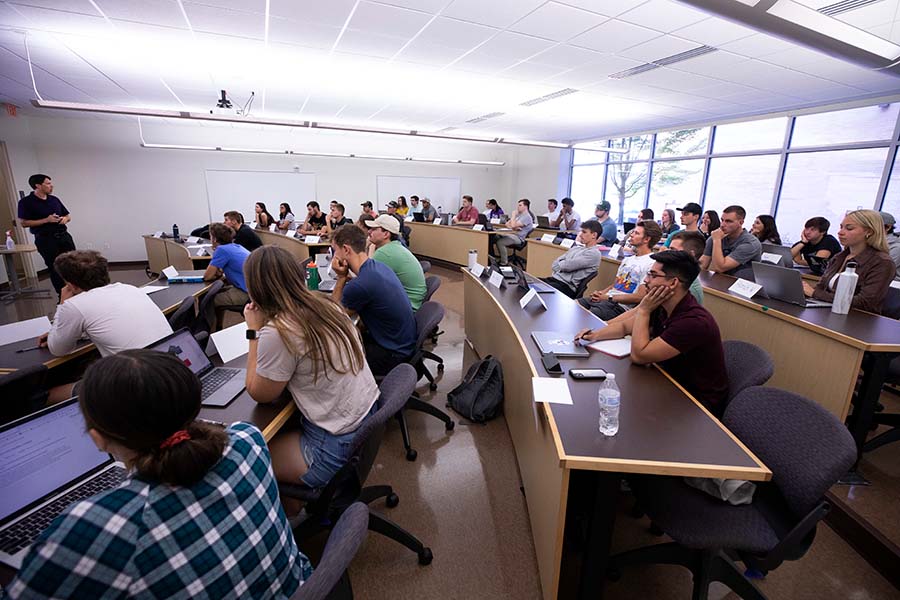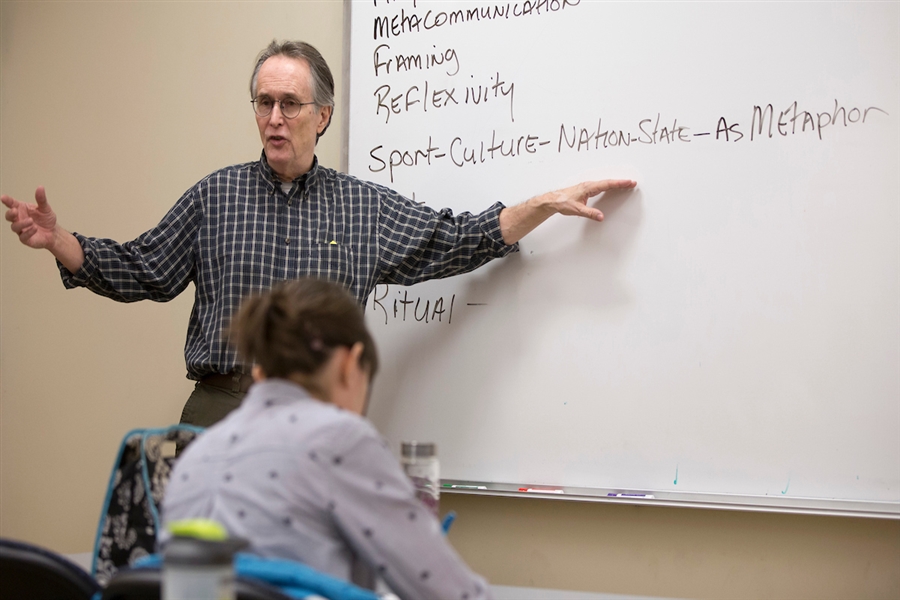Efficient Ways to Improve Student Writing
Strategies, Ideas, and Recommendations from the faculty Development Literature
General Strategies
- View the improvement of students’ writing as your responsibility.
Teaching writing is not only the job of the English department alone. Writing is an essential tool for learning a discipline and helping students improve their writing skills is a responsibility for all faculty. - Let students know that you value good writing.
Stress the importance of clear, thoughtful writing. Faculty who tell students that good writing will be rewarded and poor writing will be penalized receive better essays than instructors who don't make such demands. In the syllabus, on the first day, and throughout the term, remind students that they must make their best effort in expressing themselves on paper. Back up your statements with comments on early assignments that show you really mean it, and your students will respond. - Regularly assign brief writing exercises in your classes.
To vary the pace of a lecture course, ask students to write a few minutes during class. Some mixture of in-class writing, outside writing assignments, and exams with open-ended questions will give students the practice they need to improve their skills. - Provide guidance throughout the writing process.
After you have made the assignment, discuss the value of outlines and notes, explain how to select and narrow a topic, and critique the first draft, define plagiarism as well. - Don't feel as though you have to read and grade every piece of your students' writing.
Ask students to analyze each other's work during class, or ask them to critique their work in small groups. Students will learn that they are writing in order to think more clearly, not obtain a grade. Keep in mind, you can collect students' papers and skim their work. - Find other faculty members who are trying to use writing more effectively in their courses.
Pool ideas about ways in which writing can help students learn more about the subject matter. See if there is sufficient interest in your discipline to warrant drawing up guidelines. Students welcome handouts that give them specific instructions on how to write papers for a particular course or in a particular subject area.
Teaching Writing When You Are Not an English Teacher
- Remind students that writing is a process that helps us clarify ideas.
Tell students that writing is a way of learning, not an end in itself. Also let them know that writing is a complicated, messy, nonlinear process filled with false starts. Help them to identify the writer's key activities:
-
- Developing ideas
- Finding a focus and a thesis
- Composing a draft
- Getting feedback and comments from others
- Revising the draft by expanding ideas, clarifying meaning, reorganizing
- Editing
- Presenting the finished work to readers
- Explain that writing is hard work.
Share with your class your own struggles in grappling with difficult topics. If they know that writing takes effort, they won't be discouraged by their own pace or progress. One faculty member shared with students their notebook that contained the chronology of one of his published articles: first ideas, successive drafts, submitted manuscript, reviewers' suggested changes, revised version, galley proofs, and published article. - Give students opportunities to talk about their writing.
Students need to talk about papers in progress so that they can formulate their thoughts, generate ideas, and focus their topics. Take five or ten minutes of class time for students to read their writing to each other in small groups or pairs. It's important for students to hear what their peers have written. - Encourage students to revise their work.
Provide formal steps for revision by asking students to submit first drafts of papers for your review or for peer critique. You can also give your students the option of revising and rewriting one assignment during the semester for a higher grade. Faculty report that 10 to 40 percent of the students take advantage of this option. - Explain thesis statements.
A thesis statement makes an assertion about some issue. A common student problem is to write papers that present overviews of facts with no thesis statement or that have a diffuse thesis statement. - Stress clarity and specificity.
The more the abstract and difficult the topic, the more concrete the student's language should be. Inflated language and academic jargon camouflage rather than clarify their point. - Explain the importance of grammar and sentence structure, as well as content.
Students shouldn't think that English teachers are the only judges of grammar and style. Tell your students that you will be looking at both quality of their writing and the content. - Distribute bibliographies and tip sheets on good writing practices.
Check with your English department or writing center to identify materials that can be easily distributed to students. Consider giving your students a bibliography of writing guides, for example:
Crews, F.C. Random House Handbook. (6th ed.) New York: McGraw-Hill, 1992.
A classic comprehensive textbook for college students. Well written and well worth reading.
Lanham, R.A. Revising Prose. (3rd ed.) New York: Scribner's, 1991. Techniques for eliminating
bureaucratese and restoring energy to tired prose.
Tollefson, S. K. Grammar Grams and Grammar Grams II. New York: HarperCollins, 1989,
1992. Two short, witty guides that answer common questions about grammar, style, and usage. Both are fun to read.
- Science and Engineering
Barrass, R. Scientists Must Write. New York: Chapman and Hall, 1978. Biddle, A. W., and Bean, D. J. Writer's Guide: Life Sciences. Lexington, Mass.: Heath, 1987. - Arts and Humanities
Barnet, S. A Short Guide to Writing About Art. Boston: Little, Brown, 1989. Goldman, B. Reading and Writing in the Arts. Detroit: Wayne State University Press, 1978. - Social Sciences
Biddle, A. W., Fulwiler, T., and Holland, K.M. Writer's Guide: Psychology. Lexington, Mass,:
Heath, 1987.
McCloskey, D. N. The Writing of Economics. New York: Macmillan, 1987.
- Ask a composition instructor to give a presentation to your students.
Invite a guest speaker from the composition department or student learning center to talk to your students about effective writing and common writing problems. Faculty who have invited these experts report that such presentations reinforce the values of the importance of writing. - Let students know about available tutoring services.
Individual or group tutoring in writing is available on most campuses. Ask someone from the tutoring center to give a demonstration in your class. - Use computers to help students write better.
Locally developed and commercially available software are now being used by faculty to help students plan, write, and revise their written work. Some software available allows instructors to monitor students' work in progress and lets students collaborate with their classmates.
Assigning In-Class Writing Activities
- Ask students to write what they know about a topic before you discuss it.
Ask your students to write a brief summary of what they already know or what opinions they hold regarding the subject you are about to discuss. The purpose of this is to focus the students' attention, there is no need to collect the summaries. - Ask students to respond in writing to questions you pose during class.
Prior to class starting, list two or three short-answer questions on the board and ask your students to write down their responses. Your questions might call for a review of material you have already discussed or recalling information from assigned readings. - Ask students to write from a pro or con position.
When presenting an argument, stop and ask your students to write down all the reasons and evidence they can think of that supports one side or the other. These statements can be used as the basis for discussion. - During class, pause for a three-minute write.
Periodically ask students to write freely for three minutes on a specific question or topic. They should write whatever pops into their mind without worrying about grammar, spelling, phrasing, or organization. This kind of free writing, according to writing experts, helps students synthesize diverse ideas and identify points they may not understand. There is no need to collect these exercises. - Have students write a brief summary at the end of class.
At the end of the class period, give your students index cards to jot down the key themes, major points, or general principles of the day's discussion. You can easily collect the index cards and review them to see whether the class understood the discussion. - Have one student keep minutes to be read at the next class meeting.
By taking minutes, students get a chance to develop their listening, synthesizing, and writing skills. Boris (1983) suggests the following:
-
- Prepare your students by having everyone take careful notes for the class period, go home and rework them into minutes, and hand them in for comments. It can be the students' discretion whether the minutes are in outline or narrative form.
- Decide on one to two good models to read or distribute to the class.
- At the beginning of each of the following classes, assign one student to take minutes for the period.
- Give a piece of carbon paper to the student who is taking minutes so that you can have a rough copy. The student then takes the original home and revises it in time to read it aloud at the next class meeting.
- After the student has read their minutes, ask other students to comment on their accuracy and quality. If necessary, the student will revise the minutes and turn in two copies, one for grading and one for your files.
- Structure small group discussion around a writing task.
For example, have your students pick three words that are of major importance to the day's session. Ask your class to write freely for two to three minutes on just one of the words. Next, give the students five to ten minutes to meet in groups to share what they have written and generate questions to ask in class. - Use peer response groups.
Divide your class into groups of three or four, no larger. Ask your students to bring to class enough copies of a rough draft of a paper for each person in their group. Give your students guidelines for critiquing the drafts. In any response task, the most important step is for the reader to note the part of the paper that is the strongest and describe to the writer why it worked so well. The following instructions can also be given to the reader:
-
- State the main point of the paper in a single sentence
- List the major subtopics
- Identify confusing sections of the paper
- Decide whether each section of the paper has enough detail, evidence, and information
- Indicate whether the paper's points follow one another in sequence
- Judge the appropriateness of the opening and concluding paragraphs
- Identify the strengths of the paper
Written critiques done as homework are likely to be more thoughtful, but critiques may also be done during the class period.
- Use read-around groups.
Read-around groups are a technique used with short assignments (two to four pages) which allows everyone to read everyone else's paper. Divide the class into groups no larger than four students and divide the papers (coded for anonymity) into as many sets as there are groups. Give each group a set and ask the students to read each paper silently and decide on the best paper in the set. Each group should discuss their choices and come to a consensus on the best paper. The paper's code number is recorded by the group, and the same process is repeated with a new set of papers. After all the groups have read all the sets of papers, someone from each group writes on the board the code number from the best paper in each set. The recurring numbers are circled. Generally, one to three papers stand out. - Ask students to identify the characteristics of effective writing.
After completing the read-around activity, ask your students to reconsider those papers which were voted as excellent by the entire class and to write down features that made each paper outstanding. Write their comments on the board, asking for elaboration and probing vague generalities. In pairs, the students discuss the comments on the board and try to put them into categories such as organization, awareness of audience, thoroughness of detail, etc. You might need to help your students arrange the characteristics into meaningful categories.
Sources
The Strategies, Ideas and Recommendations Here Come Primarily From:
Gross Davis, B. Tools for Teaching. San Francisco, Jossey-Bass, 1993.
And These Additional Sources…
Boris, E. Z. "Classroom Minutes: A Valuable Teaching Device." Improving College and
UniversityTeaching, 1983,31(2), 70-73.
Elbow, P. "Using Writing to Teach Something Else." Unpublished paper, 1987.
Hawisher, G. E., and Selfe, C. L. (eds.).Critical Perspectives on Computers and
Composition Instruction. New York: Teachers College Press, 1989.
Holdstein, D. H., and Selfe, C. L. (eds.). Computers and Writing: Theory, Research,
Practice. New York: Modern Language Association, 1990.
Lowman, J. Mastering the Techniques of Teaching. San Francisco: Jossey-Bass, 1984.
Petersen, B. T. "Additional Resources in the Practice of Writing Across the Disciplines."
In C. W. Griffin (ed.), Teaching Writing in All Disciplines. New Directions in Teaching and Learning, no. 12. San Francisco: Jossey-Bass, 1982.
Professional and Organizational Development Network in Higher Education.
Bright Idea Network, 1989. (For information contact David Graf, Iowa State University, Ames.)
Pytlik, B. P. "Teaching Teachers of Writing: Workshops on Writing as a Collaborative
Process." College Teaching, 1989, 37(1), 12-14.
Tollefson, S. K. Encouraging Student Writing. Berkeley: Office of Educational
Development, University of California, 1988.
Walvoord, B. F. Helping Students Write Well: A Guide for Teachers in All Disciplines.
(2nd ed.) New York: Modern Language Association, 1986.
Watkins, B. T. "More and More Professors in Many Academic Disciplines Routinely
Require Students to Do Extensive Writing."Chronicle of Higher Education, 1990, 36(44), pp. A13-14, A16.
Do you have ideas for books, workshops, or other types of programs? Are you interested in participating in panels or facilitating sessions? We'd love to hear your suggestions! Please follow this link to a short form to enter your ideas. The LEARN Center director or staff will follow-up on all suggestions via email.















